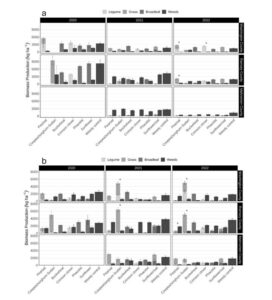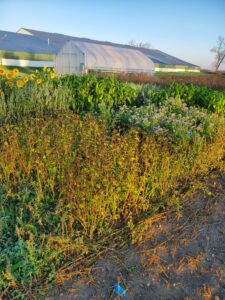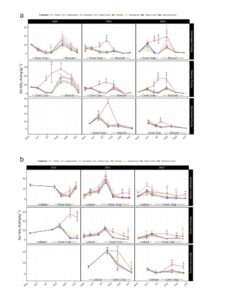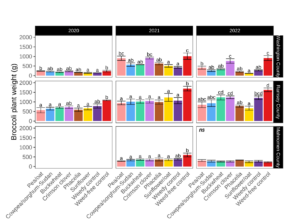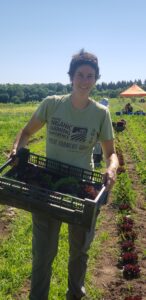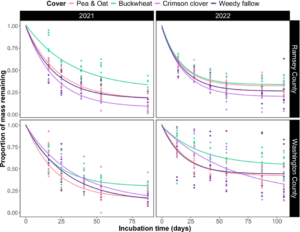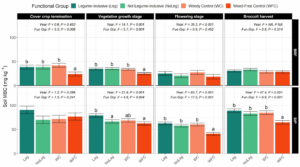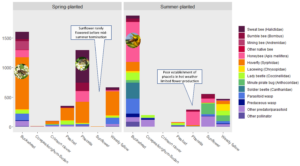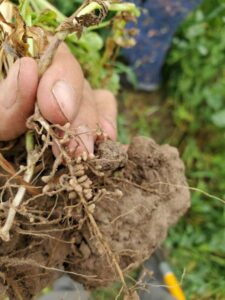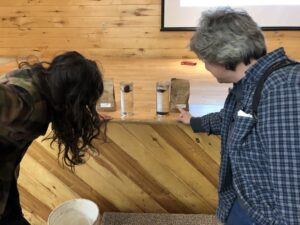Final report for LNC19-423
Project Information
This project, Summer Cover Crop System Management: New options for upper Midwest vegetable systems, worked to improve grower knowledge of summer cover crop use, including species selection, growth period timing, and management. Growers are increasingly interested in adding cover crops to rotations to improve soil health, break disease cycles, and provide ecosystem services, particularly biological nitrogen (N) fixation. Summer cover crops are an often overlooked and minimally researched option for growers in the Upper Midwest, but present a promising opportunity for fitting cover cropping into diversified vegetable rotations, which include multiple potential fallow periods due to the varying growth periods of vegetable crops.
UMN researchers worked with collaborators serving indigenous, immigrant, and underserved farmers to conduct field trials and farmer education with the goal of expanding cover crop options available to diversified vegetable growers. We conducted a three-year field experiment investigating the effects of six summer cover crop options, including legumes, legume-grass mixes, and non-legume broadleafs, on ecosystem services including nitrogen provision and retention, attraction of beneficial insects, and vegetable crop productivity. The arrival of a graduate Fulbright fellowship student allowed us to broaden the ecosystem services studied by collecting additional data on microbially mediated nutrient cycling in our treatments. We also worked with collaborating farmers to conduct demonstration plantings of summer cover crop species on their farms, and collected qualitative feedback on ease of management and effectiveness of cover cropping practices, which complemented our research findings in developing presentations aimed at enabling farmers to more profitably and confidently include cover crops in seasonal rotations, improving nitrogen management for cash crops following summer cover crops, and reducing nitrogen losses that can lead to environmental degradation.
All the cover crop species used in this trial proved to be potentially viable options for both early spring and midsummer planting at southern MN sites. However, performance was inconsistent, likely due largely to stresses during establishment. Measurements of soil N pools following cover crops suggested that, while the contribution of biologically fixed N from legumes is a valuable service, non-legume biomass (even from weeds) can also make important contributions to building long-term nutrient reserves and biologically active soils. Phacelia proved to be an appealing new broadleaf cover crop option, providing thick, weed-excluding and abundantly flowering stands highly attractive to native pollinators when establishment was successful. However, summer cover cropping did not provide an immediate yield boost to vegetable production, and in some cases resulted in yield reductions compared to a bare fallow. This indicates a need to emphasize in our outreach to farmers the role of cover crops as a long-term fertility management strategy rather than a quick fertilizer source.
Both our replicated trial results and the feedback we received from farmers who planted demonstration plots of summer cover crops reinforced the importance of trialing and teaching scale-appropriate practices for stand establishment. Small-scale and emerging farmers may be working with limited equipment, often on shared or rented land where weedy ground cover may be well established. Therefore, we should emphasize the need for favorable establishment conditions, including preparation of a weed-free seedbed, seed placement for good soil-seed contact, and adequate moisture.
We shared the results of this research through print fact sheets, web resources, and videos; and at grower meetings and on-farm field days. Educational activities focused on cover crop species and timing options for vegetable systems, cover crop establishment and termination methods for small farms, nitrogen availability from cover crop biomass, and identification of key beneficial insect families. Collaboration on this deepened the partnership between the Grossman Lab and Big River Farms, resulting in a successful joint proposal to explore farmer and educator knowledge and support needs in the emerging farm community, and develop tools for soil health planning and train-the-trainer curriculum on cover cropping and other soil health practices for educators and mentors working with emerging farmers. The activities of that project have extended the project team's ties throughout the network of organizations supporting emerging farmers, and we are actively engaged in ongoing consulting and teaching in this community.
Objective 1: Identify summer cover crop management best suited for north central vegetable growers.
Objective 2: Determine the effects of legume and non-legume summer cover crop options on nitrogen fertility and ecosystem services in organic vegetable systems
Objective 3: Develop resources on cover cropping and legume-based fertility for immigrant and minority farmers.
Immigrant, indigenous, and other emerging farmers, defined here as those who traditionally face barriers to the education and resources necessary to build profitable agricultural businesses, are a growing and often overlooked segment of our North Central region’s agricultural economy, particularly in production of fresh vegetables for local markets. These growers largely farm using organic practices, and are particularly interested in improving soil management (McCamant 2014). The system-wide outcome of this project is to increase capacity of underserved farmers to engage in sustainable soil fertility-building practices by maximizing productivity of summer cover crops in vegetable production systems.
Nitrogen pollution as a result of fertilizer leaching from agricultural production is a major concern for ecological sustainability in the Upper Midwest and around the world. In vegetable production systems, which have high nutrient requirements and are often irrigated, there is high-risk of nitrate leaching from farm fields (Agostini et al. 2010), and thus fertilizer applications can have particularly detrimental effects. Furthermore, vegetable farmers face pressure to meet financial sustainability by maximizing production, often achieved by growing multiple crops in temporal succession, resulting in reduced soil quality. Cover crops (CCs), which are crops grown in agricultural rotations for a primary purpose other than food, forage, or fiber, can mitigate nitrate losses by taking up inorganic soil N that would otherwise by subject to leaching from bare soil, retaining N for subsequent release as CC biomass decomposes. Legume cover crops, because of their ability to form symbiotic relationships with soil rhizobia that fix atmospheric nitrogen, can also contribute N to the soil, thereby increasing the fertility of agroecosystems without the used of purchased inputs. The input of nitrogen from legumes may be less likely to lead to pollution because it enters the system as part of plant biomass, and must be processed by microbes before it is susceptible to leaching. Additionally, because the N-fixation from the legume-rhizobia symbiosis is responsive to endogenous soil nitrogen levels, legume cover crops may be used as a self-regulating fertility source (Blesh 2018). This benefit may be enhanced by combining legume and non-legume species. Grass-legume mixtures may simultaneously provide nitrogen fixation and retention benefits, resulting in reduced nitrate leaching, which effectively tightens the nutrient cycling loop in soil (Blesh 2018; Finney, White, and Kaye 2016). Apart from their effects on fertilization, legume cover crops also serve other ecosystem functions. Inclusion of legume species has been shown to affect microbial community structure and function by increasing overall microbial community biomass and the proportion of Gram-negative bacteria, and fungal populations (Finney, Buyer, and Kaye 2017). Importantly, legume cover crops are often grown until flowering, which provides resources for beneficial insects (Clark 2013).
Most cover crop use is limited to cool-season over-wintering crops, which do not interfere with the summer annual cash crops that predominate in the Upper Midwest. However, vegetable production systems are well suited to take advantage of additional opportunities for cover cropping throughout the growing season, because farmers in these systems often grow both cool and warm season crops, which leads to multiple fallow periods during the growing season. A major fallow period in vegetable rotations is summer, when spring and fall vegetable crops are frequently separated by a short fallow that leaves soil bare and unused for 30-50 days in the height of summer. Unlike winter cover crops, summer cover crops do not need to be cold hardy, nor have a dormancy period. They are valued for quick, vigorous growth that may outcompete weeds. Previous research has shown that there are multiple legume and non-legume cover crops that are well suited for summer growth (Creamer and Baldwin, 2000; Candelaria-Morales et al., 2022). However, almost no previous information exists to guide farmers in effectively using this summer cover crop niche.
Cooperators
Research
This project had two driving hypotheses:
- Rotations including warm season cover crops and cool season vegetables (broccoli, greens) can be successful in the Upper Midwest, in terms of biomass production and successful production of a cash crop.
- Warm season cover crops have the capacity to positively affect soil health and N cycling through organic matter addition, biological N fixation, and N retention.
Field Experiment Overview. The field study was conducted in two sites in Minnesota in 2020, with a third site beginning in 2021. Field sites with replicated plots in 2020 included the Minnesota Agricultural Experiment Station in St. Paul, MN (StP), and Big River Farm (BRF) in Marine on St. Croix, MN. BRF is part of The Food Group and provides land access and training in organic vegetable production and marketing to new immigrant and minority farmers. Program directors at BRF expressed interest in the study because of their observation that small management changes can dramatically change the efficacy of CCs. The third site, with unreplicated demonstration plots in 2020 and replicated plots beginning in 2021, is at White Earth Nation (WEN), located in Mahnomen county and home to the White Earth Band of Anishinaabe people. Farmers at WEN were particularly interested in using this study to aid in achieving their long-term management goals of integrating CCs for fertility and soil health benefits. Changes were made to the originally proposed design of the field experiment due to farmer interest in including additional species options, and limitations on field size and staffing due to covid-19 original design. Seeding rate was not included as a treatment factor, based on clear farmer feedback that low seed rates for cover crops were unlikely to be effective. Final choices of species to include were based on interest from collaborators.
Field Site Description. Soil type at StP in Ramsey County, MN, is Waukegan silt loam (fine-silty over sandy or sandy-skeletal, mixed, superactive, mesic Typic Hapludolls). Soil type at BRF in Washington County, MN is Crystal Lake silt loam (fine-silty, mixed, superactive, frigid Oxyaquic Glossudalfs). Soil type at WEN in Mahnomen County, MN is a Hamerly-Vallers complex. The Hamerly series is a calcerous loamy till (Fine-loamy, mixed, superactive, frigid Aeric Calciaquolls). The Vallers series is a calcerous fine-loamy till (Fine-loamy, mixed, superactive, frigid Typic Calciaquolls).
Field Design and Maintenance. Experimental plots measuring 0.93 m2 were established in a randomized complete block design with four replicates in two rotational systems: one with a spring-planted CC followed by broccoli (CCV) and the other with a summer-planted CC (VCC) preceded by lettuce (Figure 1). In each system, CC treatments included one legume monoculture, three non-legume monocultures, two legume-grain mixtures, and weedy and weed-free fallow controls (Table 1). CCs in CCV were terminated mid-summer by mowing and incorporation, while CCs in VCC were mowed after frost-induced senescence and incorporated the following spring. Monoculture seeding rates were based on recommendations from Clark (2007) and seed suppliers and mixture seeding rates were based on data from Young-Mathews (2017). Primary tillage with a rototiller occurred each spring as soon as temperature and moisture conditions were suitable, typically mid-April, but was delayed in 2020 due to COVID-19 related restrictions. Secondary tillage with a field finisher occurred within a day of seeding or transplanting. Primary and secondary tillage were repeated in each system in July, following lettuce harvest in VCC and cover crop termination in CCV.
Figure 1: Rotation timing for early-planted (CCV) and late-planted (VCC) cover crop treatments
Table 1. Cover crop species treatments
| Species | Functional group |
| Crimson clover | Legume |
| Buckwheat | Non-legume; high flowering |
| Phacalia | Non-legume; high flowering |
| Sunflower | Non-legume; high flowering |
| Oat/Pea | Non legume/legume mix |
| Sudex/Cowpea | Non legume/legume mix |
| Weedy Fallow | Control |
| Bare Fallow | Control |
Cash Crop Production. To assess CC impacts on subsequent cash crop yields, weight data were collected at harvests of broccoli and lettuce. In VCC, head lettuce (Latuca sativa) was transplanted each spring immediately following secondary tillage, with 61 cm spacing between rows and 25 cm spacing within rows. Lettuce was harvested upon head maturity and yield was measured beginning in year 2 by weighing the 4 centermost heads from each plot. In CCV, broccoli seedlings were transplanted immediately following secondary tillage after cover crop termination. Broccoli (Brassica oleracea var. Italica) was transplanted by hand into 1.8 m twin row beds with 76 cm between twins and in-row spacing of 46 cm. Upon maturity, broccoli was harvested by hand and yield was measured by weighing the 4 centermost heads in each plot. In 2020 broccoli did not reach maturity, so yield was measured by weighing the 4 centermost plants in each plot.
Sampling. In CCV and VCC, soil was sampled at the time of CC planting, monthly throughout the duration of CC growth, and between mowing and incorporation at CC termination. Additionally, SpCC soils were sampled at broccoli planting and monthly during broccoli growth. At each sampling, a soil probe of 1.9 cm inner diameter was used to collect 10 cores of 15.2 cm depth from random locations within each plot. At WEN, soils were sampled to a depth of 10.2 cm because of rocky conditions deeper in the soil profile. Samples were separated into portions for air-drying and fresh analysis. In all treatments, aboveground biomass was sampled prior to CC termination. Two 1-m2 quadrats were collected from each plot, sorted by species, and dried at 63 °C.
Data collection
Soil Nitrate. To measure KCl extractable soil NO3-–N content for each sampling date, air dried soils were ground to 2 mm to homogenize, and shaken in a 1 M KCl solution to extract soil NO3. Microplate colorimetric analyses were performed on soil extracts based on the Greiss (Doane & Horwáth, 2003) reaction to determine extractable NO3-–N concentrations. We expected that all CC systems would maintain relatively low NO3-–N concentrations because of continuous uptake, and that legume CCs would provide flushes of NO3-–N after termination because of rapid tissue decomposition and N mineralization. Potentially Mineralizable Nitrogen. Potentially mineralizable N (PMN) was measured through 7 d, anaerobic incubations of soils collected at periods of peak biological activity in each rotation according to Drinkwater et al. (1996). Fresh soils were extracted as described above for NO3 to determine baseline NO3-–N and ammonium-N (NH4+–N) content. A duplicate soil aliquot was incubated under water-saturated conditions at 37 °C for 7 d, then extracted and colorimetrically analyzed for NO3-–N as described above, as well as for NH4+ based on the Berthelot reaction (Sims et al., 1995). PMN was calculated as the difference between total NO3- and NH4+ before and after incubation. We expected that all CC treatments would increase PMN, with leguminous CCs creating the most significant increases. Potentially Leachable Nitrate. Potentially leachable NO3-–N (PLN) was measured using buried nitrate exchange resin lysimeters. Lysimeters were constructed by loading 14.8 mL of nitrate-specific, mixed bed resin particles (Purolite Ion Exchange Resins; Philadelphia, PA; type A520E) into an Organza mesh bag and sewing shut to a definitive area of 7.6 cm x 7.6 cm. In each plot at StP only, 3 lysimeters were buried to a depth of 30 cm and laid completely flat. In 2020, resin lysimeters were buried only in the second stage of each rotation (cash crop stage for SpCC and cover crop phase for SuCC). Lysimeters were buried just prior to seeding/planting and then excavated from SpCC at broccoli harvest and from SuCC before soil freeze. In subsequent years, lysimeters were buried just prior to seeding or planting in each stage of each rotation, then excavated prior to the following seeding or planting. Excavated lysimeters were extracted in 3 M KCl, filtered through Whatman #42 filter paper and analyzed for NO3-–N as described above. We expected that all cover crop treatments would decrease PLN relative to no cover crop, but that non-leguminous cover crops would be more effective at reducing PLN than leguminous cover crops because of their scavenging abilities. Cover crop biomass-C and -N. After drying, biomass was ground and stored at room temperature until analysis. Ground tissue was analyzed for C and N content by combustion in an Element Analyzer (Elementar, Langenselbold, Germany). We expected C:N ratios of non-leguminous CCs would be higher than leguminous CCs, creating potential for N immobilization which may be mitigated in CC mixtures. Permanganate oxidizable carbon: Labile or active soil carbon fraction was measured as permanganate oxidizable C (POXC; Weil et al., 2003; Schindelbeck et al., 2016). Briefly, soil samples were shaken in a solution containing 20 mL of 0.02 M KMnO4,, and supernatant was colorimetrically analyzed for remaining KMNO4 content following reaction with soil C. Microbial biomass carbon and nitrogen. Microbial biomass determination was measured through a chloroform fumigation extraction method described by Fierer et al. (2003). Two sets of 10 g soil per sample were treated with 40 mL of 0.5 M K2SO4, and 0.5 mL of chloroform (CHCl3) was added into one set of samples. Tubes were placed in a reciprocal shaker at 120 rpm for 4 hours, then let to settle for 1 hour, and supernatants were filtered through Whatman No. 1 filter paper. Samples were analyzed on a Shimadzu TOC (Total Organic Carbon) and TN (Total Nitrogen) analyzer (Kyoto, Japan). Cover crop biomass decomposition: Pre-labeled nylon bags of dimensions 8 x 10 cm2 were filled with a pre-weighed quantity of fresh chopped cover crop biomass and stitched closed. Twelve decomposition bags were buried immediately after cover crop termination to a 10 cm depth. Two decomposition bags were retrieved 15, 30, 45, 60, and 90 days after burial in 2021. An extra time point at 120 days was included in 2022. Bags were oven-dried at 60 ºC, brushed to detach adhered soil, and weight was recorded. A 0.5 g subsample was ignited at 500 ºC in a furnace to obtain the mineral soil fraction that was then subtracted from the plant biomass dry weight. Beneficial insect visits: in the 2020 and 2021 seasons arthropod communities were sampled at StP every 6 to 8 days during the flowering period of the cover crops. Vacuum sweeps were carried out within a designated subsampling area for 60 seconds, using a Heavy-Duty Hand-Held DC Vacuum from BioQuip. After vacuum collection, arthropods were preserved in a -20 °C freezer until specimens were identified to the lowest appropriate taxonomic level using the keys provided by Triplehorn et al. (2005) and Marshall (2006), as well as photographs and descriptions available in www.BugGuide.net. Samples were organized phylogenetically after being verified by Dr. Ralph Holzenthal, Department of Entomology, University of Minnesota, and Jessica Miller, M.S., bee and environmental ecosystem specialist. Statistical analysis: The effects of site, sampling time point, and cover crop treatment on soil and biomass parameters were assessed through mixed model analysis of variance (ANOVA) with block replicates as random factor using the lme4 package in R version 4.3.1 (R Core Team 2023). Correlations between variables were analyzed using the corrr package.
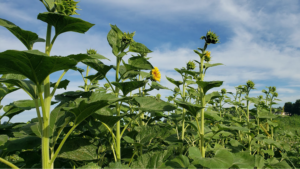
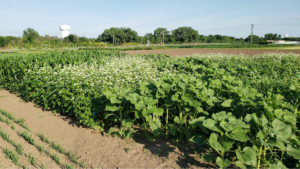
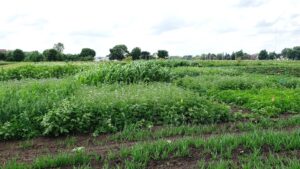
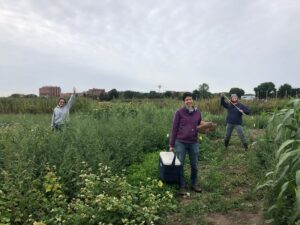
Cover crop performance
In the CCV rotation, total biomass (cover crops + weeds) ranged from 628-13,350 kg biomass ha-1 and averaged 3,160 kg ha-1 across cover crop treatments and site-years. Stand establishment was observed to be highly variable in all CC species, with considerable competition from early-emerging weeds as well as seed predation by birds and rodents. Establishment of early spring-planted CCs (CCV; fig. 1a) was uniformly poor at the far-northern WEN site; however, midsummer-planted CCs (VCC; fig. 1b) competed successfully with weeds and produced up to 3048 kg ha-1 of biomass. In the VCC rotation, cowpea/sorghum-Sudan was frequently the most productive cover crop treatment, producing up to 6419 kg/ha of biomass. This warm-season mix was also was the only treatment to produce more biomass during the droughty summers of 2021 and 2022 than in 2020. In other treatments, biomass production in each site-year was usually equal to the biomass of the weedy control, except in pea/oat plots in Ramsey County in 2022, in which biomass production was less than the weedy control. In grass/legume mixture treatments, the proportion of legume biomass in the mixture varied widely among sites and years, with generally higher proportions of legume biomass at the lower-fertility BRF site than the relatively high-fertility StP site.
Figure 1. Biomass production by early-planted (a) and midsummer-planted (b) summer cover crops, 2020-22.
A long, warm fall allowed ample time for summer-planted phacelia and sunflower to bloom at White Earth
Nitrogen fertility
In the CCV rotation, soil NO3–N (Fig. 2a) declined between CC planting and termination in all treatments except the weed-free control, indicating uptake of available soil N by cover crops (including legumes) and weeds. In the 30 days following CC termination, NO3–N consistently increased in all treatments except the weed-free control, indicating the release of N from incorporated biomass during this period. In some site-years, NO3–N in the weed-free control continued to increase during the subsequent 30-day period, (e.g. 2020 at StP), while in other site-years, NO3–N declined (e.g. 2021 at all sites; Fig. 5). N release tended to be greater in legume than non-legume treatments, with NO3–N levels similar in crimson clover, pea/oat, and cowpea/sorghum-Sudan to those in bare fallow in some site-years. Soil NO3–N levels in the VCC rotation (Fig. 2b) also indicated uptake of soil N by cover crops and weeds during the first 30 days of CC growth, followed in most cases by increases in NO3–N during the subsequent lettuce cropping season, due to N mineralization from soil organic matter and previously incorporated biomass. In both rotations, potentially mineralizable soil N was higher in cover crop and weedy fallow treatments than in bare fallow, indicating that incorporated plant biomass was contributing to the pool of N available for long-term release.
Figure 2. Soil nitrate during cover crop and subsequent vegetable crop growth in early-planted (a) and midsummer-planted (b) cover crop treatments, 2020-22.
Nitrate leaching loss, as measured by cumulative nitrate capture on buried resin lysimeters, was generally lower in cover crop and weedy fallow treatments than in bare fallow in the CCV rotation, although the difference was significant only for phacelia (Table 1). In the VCC rotation, nitrate leaching loss did not differ among treatments.
Table 1. Cumulative sum of resin lysimeter NO3-N over all burial periods (2021-22) in early-planted (CCV) and midsummer-planted (VCC) cover crops and subsequent vegetable crops.
| Cumulative resin lysimeter NO3-N, kg ha-1 | ||
| Treatment | CCV | VCC |
| Pea/oat | 171.2 ab | 201.2 A |
| Cowpea/sorghum-Sudangrass | 152.0 ab | 137.7 A |
| Buckwheat | 154.6 ab | 227.9 A |
| Crimson clover | 176.4 ab | 192.9 A |
| Phacelia | 138.2 a | 179.5 A |
| Sunflower | 170.4 ab | 141.6 A |
| Weedy fallow | 164.1 ab | 171.8 A |
| Weed-free fallow | 289.1 b | 198.6 A |

Cash crop performance
In the CCV rotation, broccoli yields were higher following bare fallow than following cover crops or weedy fallow (Figure 3). Yields were also lower in the VCC rotation in spring lettuce following cover crops grown the previous fall, although differences were not statistically significant at most site-years. Because this pattern was observed even when soil nitrate availability was similar among treatments during the majority of the vegetable growth period, it is likely that factors other than nutrient availability contributed to the observed reduction in vegetable yields with cover cropping; in particular, soil moisture use by cover crops and weeds. Moisture monitoring by undergraduate research program (UROP) student Sarah Duber in 2021 confirmed that soil moisture was significantly higher in weed-free fallow than in cover crop and weedy treatments, even when irrigation was applied.
Figure 3: Broccoli plant weights following spring cover crop growth, 2020-22
We harvested a lot of lettuce!
Cover crop biomass decomposition
Cover crop biomass decomposition rates were highest during the first 30 days post cover crop termination (Figure 4). During this period, covers lost up to 53% of biomass. On average for both locations and years, the clover, pea and oat mixture, and weedy fallow treatments lost 10% more biomass than the buckwheat treatment during the 90-day decomposition period. However, the effect of cover crop species treatment on mass remaining varied between years and sites, with the greatest difference at Ramsey County in 2021. Mass remaining from buckwheat was 21% higher than for the averaged three other treatments. Overall, mass remaining was 11% lower at the Ramsey County site than at the Washington County location; and it was also 11% lower in 2021 compared to 2022.
Figure 4. Decomposition mass loss from cover crop biomass following termination, 2021-22.
Microbial biomass
At BRF soil microbial biomass-C (MBC) was higher following cover crops or weeds than following bare fallow at some timepoints (Figure 5): at BRF at the time of cover crop termination (before broccoli planting) and during early growth of transplanted broccoli, and at StP during early broccoli growth, broccoli flower initiation, and at broccoli harvest. Additionally, MBC was higher following legume cover crops than non-legumes in at StP during early broccoli growth. These results reinforce the importance of living plant cover for promoting active soil microbial communities, and although not definitive, suggest that legume species may be more conducive to microbial community activity than non-legumes.
Figure 5. Soil microbial biomass-C following cover crop termination, 2021-22 average values
Beneficial insect visitation
Phacelia and buckwheat attracted the greatest abundance of beneficial arthropods (Figure 6). Predominant groups included syrphid flies, which can act as both pollinators and pest predators; bees, including honeybees and wild bees; and minute pirate bug, a predator of common agricultural pests such as aphids and thrips. Sunflower was also highly attractive to beneficial arthropods when blooming, although its longer time to flowering meant that it did not consistently bloom in these timeslots before being terminated or winter-killed. The leguminous cover crops, crimson clover, field pea, and cowpea, attracted fewer pollinators and overall fewer beneficial arthropods than the weedy fallow treatment.
Figure 6. Insect visitation of flowering cover crops in research plots planted in early spring (left) and mid-summer (right) in Washington and Ramsey counties, MN. Values represent total observations over the cover crop flowering period in the 2020 and 2021 seasons at both sites
On-farm demonstration plots
Three collaborating farmers planted unreplicated plots using one or more cover crop treatments of their choice, and reported their observations to the research team. Two farmers reported difficulty establishing buckwheat and crimson clover in areas with well-established weed populations, although one also reported observing pollinator visits to flowering CCs. One farmer seeded a cowpea and sorghum-Sudangrass mix in alternating rows using a hand-pushed Earthway seeder. Although emergence and early growth were slow, this farmer ultimately obtained tall, dense stands.
All the cover crop species used in this trial proved to be potentially viable options for both early spring and midsummer planting at southern MN sites, each producing over 1500 kg ha-1 of biomass in at least one site-year in each rotation. However, performance was inconsistent, likely due largely to stresses during establishment, primarily weed competition and seed predation in early spring, and intense heat in midsummer. For northern MN, our results do not indicate benefits from early spring cover cropping, as cover crops produced consistently low biomass, while allowing insufficient time for head production in a following broccoli crop.
Both legume and non-legume cover crops contributed to potential retention of soil N by taking up available soil nitrate during growth, resulting in greater reserves of stored N for long-term release, accompanied by greater microbial biomass. Legume cover crops tended to provide greater release of mineral N following termination than non-legumes. This suggests that, while the contribution of biologically fixed N from legumes is a valuable service, non-legume biomass (even from weeds) can also make important contributions to building long-term nutrient reserves and biologically active soils.
Summer cover cropping did not provide an immediate yield boost to vegetable production, and in some cases resulted in yield reductions compared to a bare fallow. This indicates a need to emphasize in our outreach to farmers the importance of moisture management when planting vegetables following a cover crop, as well as the role of cover crops as a long-term fertility management strategy rather than a quick fertilizer source.
An astonishing variety of beneficial insects visited the flowering summer cover crops in this trial. However, the legume species in this trial tended to attract fewer pollinators than the abundantly flowering non-legumes. In addition to the more familiar buckwheat, phacelia proved to be an appealing new broadleaf cover crop option, providing thick, weed-excluding and abundantly flowering stands when establishment was successful; however, phacelia also proved difficult to establish under very hot conditions.
Both our replicated trial results and the feedback we received from farmers who planted demonstration plots of summer cover crops reinforced the importance of trialing and teaching scale-appropriate practices for stand establishment. In our experience, most cover crops will not “catch up” from a poor or weedy start, although we sometimes observed exceptions to this in tall-growing, heat-loving species: cowpea, sorghum-Sudangrass, and sunflower. Small-scale and emerging farmers may be working with limited equipment, often on shared or rented land where weedy ground cover may be well established. Therefore, we should emphasize the need for favorable establishment conditions, including preparation of a weed-free seedbed, seed placement for good soil-seed contact, and adequate moisture.
Peas nodulated beautifully at Big River Farms!
Education
Our educational approach was guided by our Objective 3: to develop resources on cover cropping and legume-based fertility for immigrant and minority farmers. While we also presented project findings to academic and mainstream farmer audiences, we prioritized immigrant and minority growers and the educators who support these growers, by holding pollinator ID workshops and on-farm field days in collaboration with our Big River Farms and White Earth Nation project partners at their farm sites serving immigrant and indigenous growers, for which our partner organizations' farmers and community members were the primary audience. In developing educational video resources, our team targeted cover cropping guidance to the needs of these growers, who in many cases are farming on very small land area and with shared or limited access to mechanized equipment.
Project Activities
Educational & Outreach Activities
Participation Summary:
Objective 3: Develop new cover crop legume resources, and make existing resources more available, for immigrant and minority farmers in the North Central region.
Some planned activities associated with our third objective were delayed by Covid-19, due to the need for social distancing. However, the switch to online activities enabled us to present at a large number of virtual conferences and trainings during 2020-21, as well as producing online and video resources. When group field days were not possible in 2020, educational signage (with SARE logo) was placed on all treatment plots at Big River Farms to allow farmers on the site to learn about the cover crop species, benefits of summer cover crops, and project partners. As in-person events become possible, we rescheduled delayed field days, and continued to present conference sessions and workshops. Additionally, two manuscripts for peer-reviewed journals are in development that will describe agronomic performance and nitrogen cycling effects of summer cover crops in our field trials, as well as dynamics of cover crop biomass decomposition and microbial nutrient cycling.
Collaboration on this project has deepened the partnership between the Grossman Lab and Big River Farms, resulting in a successful joint proposal to the UMN Institute on the Environment's Impact Goals program, to explore farmer and educator knowledge and support needs in the emerging farm community, and develop tools for soil health planning and train-the-trainer curriculum on cover cropping and other soil health practices for educators and mentors working with emerging farmers. The activities of that project have extended the project team's ties throughout the network of organizations supporting emerging farmers, and we are actively engaged in ongoing consulting and teaching in this community.
Learning Outcomes
- Cover crop establishment and temination methods for small farms
- Identification of key beneficial insect families
- Timing of expected nitrogen availability from cover crop biomass
- Cover crop species and timing options for vegetable systems

